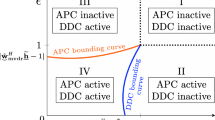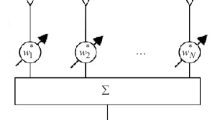Abstract
This paper considers array processing for wideband signals. The optimization techniques and associated performance results correspond to steerable but fixed beam microphone arrays, to be used in hearing aid applications, both in free-space and reverberant conditions. We first review the results on maximum energy (ME) broadband arrays. We subsequently formulate optimization criteria for array subband processing. The uniformly spaced subband and the non-uniformly spaced subband using quadrature mirror filter approaches are treated. Finally, various simulation results for free-space and reverberant conditions are presented to demonstrate the usefulness of this class of microphone arrays, as well as the feasibility of quadrature mirror filter-based subband processing.
Similar content being viewed by others
References
S. Haykin and A. Steinhardt (Eds.),Adaptive Radar Detection and Estimation, J. Wiley, New York, 1992.
D. Korompis, K. Yao, and F. Lorenzelli, “Broadband maximum energy array with user imposed spatial and frequency constraints,”Proc. IEEE ICASSP, 1994.
D. Korompis, K. Yao, R. Hudson, and F. Lorenzelli, “Microphone array signal processing for hearing aid applications,”VLSI Signal Processing VII, IEEE Press, 1994.
K. Yao, “Maximum energy window with constrained spectral values,”Journal of Signal Processing, 1986.
G.H. Golub and C.F. Van Loan,Matrix Computations, Johns Hopkins Press, Baltimore, MD, 2nd Edition, 1989.
A.N. Akansu and R.A. Haddad,Multiresolution Signal Decomposition, Acad. Press, 1992.
Z. Jiang, A. Alwan, and A.N. Willson, Jr., “High-performance IIR QMF banks for speech subband coding,”Proc IEEE ISCAS, June 1994.
S.R. Quackenbush, T.P. Barnwell III, and M.A. Clements,Objective Measures of Speech Quality, Prentice Hall, pp. 35–59.
P. Peterson, “Simulating the response of multiple microphones to a single acoustic source in a reverberant room,”JASA, Vol. 80, No. 5, pp. 1527–1529, 1986.
H. Cox, R. Zeskind, and M. Owen, “Robust adaptive beamforming,”IEEE Trans. Acous., Sp., Signal Proc., Vol 35, No. 10, dy1987.
M.H. Er and S.K. Hui, “Beamforming in presence of element failure,”Electronics Letter, Vol. 27, No. 3, 1991.
Author information
Authors and Affiliations
Additional information
This work was partially supported by the House Ear Institute and the Retirement Research Foundation.
Rights and permissions
About this article
Cite this article
Lorenzelli, F., Wang, A., Korompis, D. et al. Subband processing for broadband microphone arrays. J VLSI Sign Process Syst Sign Image Video Technol 14, 43–55 (1996). https://doi.org/10.1007/BF00925267
Received:
Revised:
Published:
Issue Date:
DOI: https://doi.org/10.1007/BF00925267




